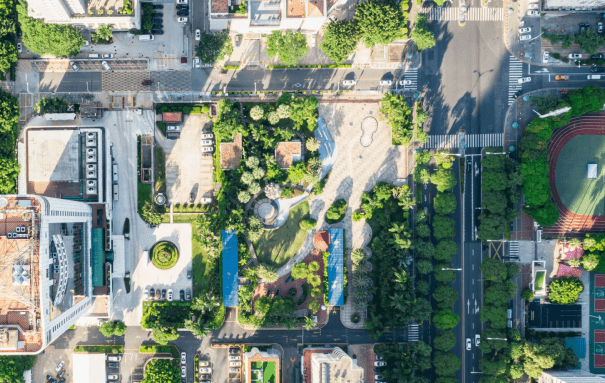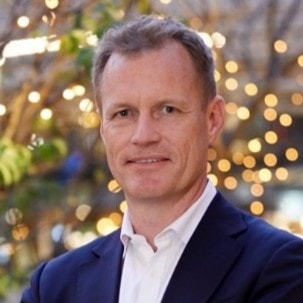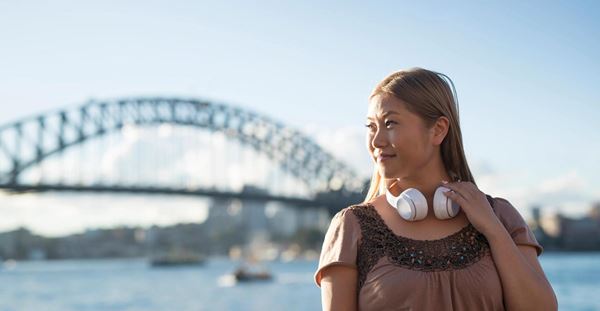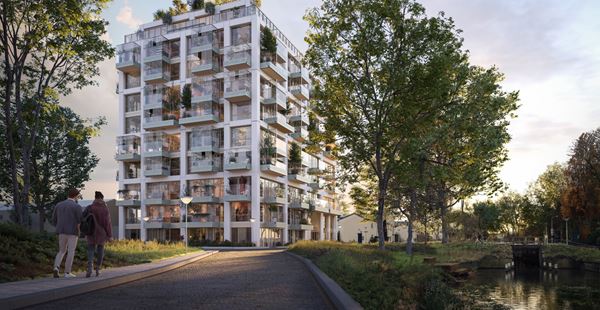It's rare that developers can create entirely new neighborhoods in a place that's so central to the CBD of a city. So it was a privilege and a responsibility for us as a team to work out how we could turn it back into a place that people could live, work, and enjoy.
Darling Harbour is a bustling area in Sydney, Australia, which attracts millions of visitors each year. But this area is also one of the city’s oldest, heritage industrial sites. In this episode of Better Cities by Design, we spoke with Neil Arckless, Group Executive for Development at the global property and infrastructure company, Lendlease. Lendlease is the company behind the master plan for the Darling Square section of Darling Harbour. Darling Square is now one of the greenest and most sustainable urban precincts in the world.
You have not accepted cookies yet
This content blocked. Please accept marketing cookies. You can do this here.
Subscribe on your favourite platform
Group Executive for Development Neil Arckless joins the show to discuss the work that Lendlease has done to regenerate Sydney’s Darling Square, which is part of Darling Harbour. Like many urban areas, Darling Harbour faces many sustainability challenges, from air pollution to water scarcity, as well as the pressures of urbanization. The New South Wales Government decided to renew this part of Sydney, with a focus on making it into a highly attractive, mixed-use area, which both business, residential, and commercial space. And sustainability was also a core consideration.
Darling Square is a major redevelopment project led by the property and infrastructure company Lendlease. Lendlease is a globally integrated real estate group, responsible for projects such as Sydney’s award-winning Barangaroo precinct, London’s Elephant Park urban renewal, and Boston's Clippership Wharf. At Darling Square, the company has developed innovative sustainability solutions to create a more liveable and equitable urban environment. Neil shares how the redevelopment project transformed the area into a healthier and vibrant urban neighborhood for over 4200 people to live and work, right in Sydney’s central business district. He also talks about the pride he feels when he visits Darling Square, knowing that Lendlease has helped create a space that not only serves residents, but also truly belongs to them.


The Arcadis global podcast
Better Cities by Design
Episode transcript:
We recognize that not everyone is able to listen to our podcast, which is why the show is also available in text. If you would prefer to read what happened in the show instead of listening, please click the link below for the episode transcript.
-
Read full transcript
00:04
Davion Ford
Welcome to Better Cities by Design, a podcast brought to you by Arcadis where we talk to changemakers who are working to make our cities better places for people to live, work and play. I'm your host Davion Ford. This week we're headed to Sydney, Australia to speak with Neil Arckless, Group Executive for Development at Lendlease, the global property and infrastructure company behind the master plan for Darling Square. Located in Darling Harbour, Darling Square is part of a 3.4 billion Australian Dollar redevelopment project from the government of New South Wales. And it's achieved a six star Green Star communities rating in 2016, making it one of the greenest and most sustainable urban precincts in the world.
00:59
Davion Ford
Sydney is a city of contrast. It's home to some of Australia's wealthiest residents, as well as some of its most disadvantaged communities. It's a place of natural beauty with stunning beaches and a picturesque harbor. But it's also a city facing serious sustainability challenges. One area where these contrasts are particularly evident is Darling Harbour. Nowadays the precinct is a bustling tourist destination that attracts millions of visitors each year. Before it was known as Darling Harbour, the area was home to aboriginal people, the Gadigal, who lived and thrived on this land for thousands of years. Today, the Gadigal people continue to play an important role in the cultural life of Sydney, and their history and traditions are an integral part of the city's identity. But it's also a place where the impacts of climate change and urbanization are keenly felt. Some of Sydney's wealthiest residents live in the nearby waterfront apartments, while just a few kilometers away, there are neighborhoods with some of the highest rates of poverty and unemployment in the city. And like many urban areas, Darling Harbour faces a number of sustainability challenges from air pollution to water scarcity. Let's hear from Michael Kurtz, Arcadis’ Technical Director for Civil Urban Development and Regeneration.
02:24
Michael Kurtz
Darling Harbour has seen considerable changes over the past years where it started as Sydney's largest harbour port in Sydney's largest rail yard before being developed as a tourist precinct as government's gift for Australia's bicentenary in 1988. Darling Harbour is a microcosm of the challenges facing many cities around the world. An underutilized and disconnected precinct did not compete on the world stage for entertainment and exhibition space. It's a place where the pressures of urbanization, climate change, social inequality converge, but it's also a great place of opportunity. Through smart urban design, innovative technologies and community engagement, we can create a more sustainable, livable and equitable urban space. The redevelopment of Darling Square is a step in the right direction. But there's still much work that we can do. We need to think creatively and collaboratively to address the complex challenges facing our cities, and to ensure that they remain vibrant, inclusive, and resilient places for generations to come.
03:28
Davion Ford
As Michael notes, Darling Harbour is facing a range of sustainability challenges that require creative and collaborative solutions. To reduce greenhouse gas emissions and become carbon neutral by 2050, the city of Sydney recently endorsed Australia's first plans to include energy targets and development applications. Starting from January 2023, new office buildings, hotels, shopping centers and major redevelopments must comply with minimum energy ratings. And by 2026, these developments must achieve net zero energy use through a combination of energy efficiency and on-site and off-site renewable energy. The new planning measures are expected to save more than 1.3 billion Australian dollars on energy bills from 2023 to 2040, create jobs in regional areas and help the city meet its target for net zero emissions by 2035. As I mentioned before, Darling Square is a major redevelopment project that was led by the property and infrastructure company Lendlease. As a globally integrated real estate group, responsible for projects such as Sydney's award winning Barangaroo Precinct, London's Elephant Park Urban Renewal and Boston's Clippership Wharf, Lendlease has set its own path to net zero carbon. At Darling Square, the company has developed innovative sustainability solutions to create a more livable and equitable urban environment. Let's now take a closer look at some of these solutions and explore the opportunities and challenges involved in redeveloping a major urban area in a sustainable and socially responsible way. I'm really excited to invite Neil Arckless to the show. He's Lendlease's Group Executive for Development.
05:20
Davion Ford
Hello, Neil, welcome to Better Cities by Design.
05:23
Neil Arckless
Thanks, Davion, it’s great to be here with you.
05:25
Davion Ford
So first things first, who is Neil Arckless? What do you do at Lendlease? And what's your connection to Darling Square?
05:34
Neil Arckless
Well, thanks, so I’ve been at Lendlease, nine years now. And I've worked across a bunch of projects around the world. Current role, I'm currently looking across overall global business. And, so what do I do? I coordinate the way Lendlease thinks about bringing a way of working in how we deliver those projects. And, I facilitate some of the knowledge share between our teams so that we can bring the best of what we do wherever we go. So I'm based at our global headquarters, here in Barangaroo in Sydney. So it's great. But Sydney, Sydney is my home. It's an amazing city, for anyone outside of Australia that hasn't spent time here. We're an amazing harbour location, we've got great weather, we've got a sort of a big focus on an outdoor lifestyle. But, like all of the cities around the world, you know, we're growing a pace. And so how we sort of think about densifying the city, and retaining the quality of life that we have here in Australia is really, really important. So Darling Square to your question, you know, the broader regeneration, real opportunity to bring regeneration expertise to a really underutilized space in the CBD. So, you know, for me, it holds really great significance. This project, I was the project director, oversaw it for five years through to its completion. And, yeah, really, really proud to have been involved. So glad to talk to you about it.
07:02
Davion Ford
So Neil, can you tell us a little bit about the significance of Darling Square, and also why it was in need of redevelopment?
07:09
Neil Arckless
Yeah, of course, so that, I mean, the site's got a rich history, from pre-European settlement place of hunting and gathering, you know, being on the edge of the water in Sydney, through to a sigh of Trade and Industry, some of Australia's first trade sites in the area, and then later the, you know, for an entertainment precinct. So it had a multitude of uses over time. And prior to redevelopment, it's used with entertainment. So it had a 12,000 seat arena, one of Sydney's most important entertainment centers on it. For 30 years, it was well loved, but it wasn't well connected. And it really did impact the walkability and feeling within the site. So its safety was questionable, people weren't using it, it was rarely visited, and, you know, really only became alive on major entertainment evenings. So it was a wasted opportunity. And government recognized that back in 2010, started to think about how they could actually bring back revenue and income back into New South Wales and made election promise “Make New South Wales Great Again”. And the principles of the master plan were to bring world class facilities back in from an entertainment and convention and exhibition perspective. And then for us to add, you know, hotels, and Darling Square as it's now known today, which was a four hectare major urban neighborhood mixing high density residential, commercial, streets, laneways, street retail and the like, so that's how it came about.
08:42
Davion Ford
So pretty clear that this part of town really was not living up to his potential in terms of serving the people there in Sydney. So what did you guys at Lendlease do to change this?
08:55
Neil Arckless
Well, look, it's rare that developers can create entirely new neighborhoods in a place that's so central to the CBD of a city. So it was really, it was a privilege and a responsibility for us as a team to work out how we could turn it back into a place that people could live, work and enjoy. And so its location’s really important. It was surrounded by four very diverse and different locations. I just talked about the lack of connection. So you know, Sydney's Chinatown is very close to the site to the east. The West has a major innovation district and in the place called Ultimo. To the North, huge part of the tourism of Sydney, you know, coming through the site, and then to the South University Precinct. So the opportunity for us to be able to sort of reconnect those diverse populations back into you know, a new place and bearing in mind 50% of residents in this area are born overseas. So real special makes and the Master Plan needed to be able to leverage that so the vision for the team and for the precinct government was about, you know, creating an enriched urban experience, the stitch together, the eclectic character of, of the community. So how can we celebrate their unique culture and the site's history. So it was about creating a new place, a new extension to the city, series of lane streets, open spaces, very much anchored by residential, office and retail, density done well was something that was really important to us. So a lot of product in a small area, but in some of the world's best cities do that extremely well. So in the end, it’s became home to over 4000 people, commercial offices for 3000 workers, a new city Square, series of streets, and laneways, and all the retail that goes with that.
10:52
Davion Ford
So a major redevelopment project like this, of course, will take quite a lot of resources and time. But it also has a really big impact on the, let's say, physical space in the city and people's ability to move around in the city. So how did you go about pulling off this project? Without it being like a massive disruption to life in this part of the city?
11:19
Neil Arckless
Yeah, like, look, it's a great point. And this, like lots of major projects in the middle of cities, had exactly some of those issues. So this is one of the most visited precincts in Australia, that we were about to do a major regeneration through. And also if people stopped visiting a place because you haven't thought about them through those phases, very trust is lost, and it's very difficult to get people back. So we decided really early on that we're going to prioritize some of those relationships and movement through the project during the construction as well as their long term. A couple of examples, we kept that we actually kept the existing entertainment center open two years beyond the start of the project, because we wanted the new theater in a different location to be open. So that was very helpful. We also created the main boulevard, the spine of this project, 20-meter wide boulevard now has millions of people moving up and down it. It was opened long before a number of the buildings were. So you know, we needed to make sure that that was safe. But we did that. Wayfinding giving people activity updates, and what's happening in the delivery was super important, because safety's number one for us Lendlease. So we needed to make sure it's safe, but we wanted to get all those people movements flowing through the site as early as we possibly could. I think the other opportunity we had that we took advantage of was, we delivered this project at speed and at pace. And you know, the quicker you can do these major regenerations, obviously, the less disruption there is to the communities that we're working in, we were spending over 100 million a month on this project for a number of years. So it was a huge undertaking. And I would say it couldn't have happened without, you know, Lendlease, and all of our key partners working with government and community properly listening to each other properly understanding with a really shared vision that allowed us to be able to deliver. And I'm proud to say and it's sort of a bit off the team that the relationships of all those parties are actually as strong today as they were when we set off. So that's always a good sign that there'll be that we've listened probably a word together.
13:29
Davion Ford
So what about, let's say the sustainability aspects of this project, we know that the construction and operation of buildings and infrastructure projects, these are all potentially massive contributors to the carbon emissions in cities. And of course, this project involved the demolition and construction of a number of large structures and buildings. What can you say about the, let's say, sustainability aspects of this effort?
13:57
Neil Arckless
Yeah, we're very lucky at Lendlease, the sustainability is absolutely core to what we do it’s been a flagship, not just recently, but over decades of work. So we've got some pretty ambitious targets as an organization where we have set ourselves a net zero by 2025, and absolute zero target by 2040. So we've sort of got a bit of a history of putting flags on the hill for the future and working out how we get there over time and, and then Darling Square was a good example of how we did that. So we wanted to create that sort of new benchmarks for urban community, and how we think about that, everything from the very early phases from demolition through to completion. So to your to your point, you raise sort of, we’re knocking down some big buildings, a couple of examples, you know, we actually crushed most of those buildings with concrete structures, and we crushed them all on site, they became the foundations for the new buildings. So there was very actually very little material taken or taken off site. Car parking is another one really interesting, right? Get there getting design teams thinking hard about how can we actually create natural ventilation through car parks, so that we're not having to mechanically ventilate. And also how are we thinking about car parks in 10-20 years time where they're not required. So you know, actually just increasing the heights of those floors so that they can be retrofitted with other uses in the future.
15:18
Davion Ford
So sort of building on that point, but maybe a little bit of a different spin around livability. In Darling Square, you already mentioned that there are about 4000 people that make their home there. Can you talk a bit about walkability, connectivity, green spaces, all of these elements that make a place? Yeah, really livable, and the type of place that people want to be in?
15:40
Neil Arckless
Yeah, absolutely. And it's, by its very nature of the Master Plan. It's a highly walkable place, and it has great access to amenities. So we talked a lot about the 20-Minute living models of how do we actually give access to people, both from a walkability and connection perspective, but you know, the laneways, and the streetscapes are carfree through the center of the precinct. So it's a place now that people will come from all over Sydney, to, because it's safe for the families they can, it feels safe for a number of reasons. One, there's people on the street. So it feels safe, but also they know they're in a pedestrian zone carfree lots of space to be able to amble. So, really did start to focus on that kind of connectivity.
16:25
Davion Ford
So my final question for you, Neil, is, what is it like to actually be down in Darling Square? And maybe I'll just add on to that. You have been so involved in this project, what are the hallmarks of the success of this project for you?
16:43
Neil Arckless
Yeah, look, I think sort of one of the hallmarks of success for me, I think about the community engagement and government relationships and stakeholder relationships are really, really important on this project. And that goes to everybody in the team. And you know, Arcadis had a key role in that as well. And so we'd never been able to achieve what we did without everybody working together around an aligned vision. And most smart ideas came from those conversations as open, honest conversations. I think, you know, they're examples of things that we did in that project, where we didn't try and determine exactly how the community would act in the future, what we did is we tried to facilitate the potential. And so to give you an example, you know, in the old Convention Center, I mentioned, dancers will be dancing in the windows, when the Convention Center was shut. So how can we actually facilitate those dancers to come back one day, and not to tell them, there's the windows that you must dance by, to give the very opportunity for them to be able to do it. And if you go down there today, it's a nice sunny day here in Sydney, I reckon there'd be 50 dancers down there. And they're not where we told them to go, they’re wherever they want to go. But we sort of facilitated the potential of those kinds of things. I think the collaboration that I mentioned, allowed some buildings to go well beyond where they potentially could have. So you know, there's a flagship building in the middle of the precinct that's community related. It's around building designed in Japan by Kengo Kuma. It has a city library, childcare, restaurants at a market hall, that was meant to be a small residential building. Those things can't happen without key vision. So I think it's to me, it's a testament. Now when you go down there, and we've got feedback that people don't even realize it's only three or four years old, they think it's been there forever. And that's really important. And when I sort of go down there, myself, and I see someone walking down the street with their dog, and you can see they own the street, it's theirs, it's ours, that's a sign of success. So I think, you know, as developers, engineers, governments, if we can start to think about those things on projects, then then we know that we're going okay.
18:57
Davion Ford
So for our listeners out there, it sounds like when you make it over to Sydney, you owe it to yourself to drop into Darling Square to check it out. Neil, really appreciate your time. Thanks for joining the show.
19:09
Neil Arckless
Yeah, pleasure. Thanks for having me. Appreciate it.
19:12
Davion Ford
That's all for this episode of the show. I want to give a big thank you to Neil Arckless from Lendlease for joining us. And for all of you out there, please stay tuned for future episodes as we continue to bring changemakers to the table who are driving progress and urban development. And if you haven't already, please be sure to subscribe, and also check out our other episodes. I’m Davion Ford, and you've been listening to Better Cities by Design. A podcast brought to you by Arcadis, the world's leading company delivering sustainable design, engineering and consultancy solutions for natural and built assets. You can learn more by visiting our website arcadis.com or by following Arcadis on LinkedIn or Facebook. And please stay curious, get inspired and remember, the future belongs to those who daring to make a difference in the cities we call home.




